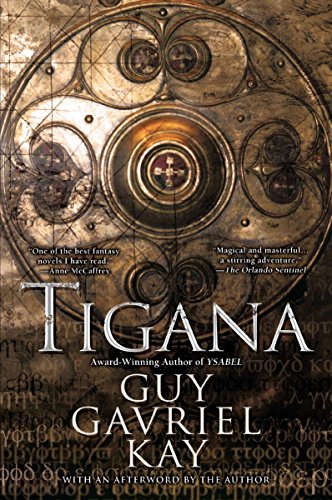Guy Gavriel Kay, Tigana
reviewed by Alison McBain

Tigana Publisher: Ace Date: December 1, 1999 Special 10th Anniversary edition Length: 676 pages ISBN: 0451457765; 9780451457769 |
I often write historically-influenced fantasy fiction, and so it is also one of my great favorites to read--especially when it’s done with such artistry and beauty as the work of Guy Gavriel Kay. His fantasy world-building is as complex and nuanced as works such as Frank Herbert’s Dune or Elizabeth Moon’s Deed of Paksenarrion.
Yet Guy Gavriel Kay has the heart of a poet, turning what should be simple scenes into heartbreaking ones, invoking the reader’s immediate sympathies for complex characters both good and bad. His villains always bring to my mind the quote by Mary Wollstonecraft: “No man chooses evil because it is evil; he only mistakes it for happiness, the good he seeks.”
Kay’s classic story Tigana is no exception to the rule. Having read almost all of Kay’s published work, I’d have to say there are several themes that stretch across his work as a whole.
One is war. Often, the characters are on opposing sides of an armed conflict, and they can’t always see their way to the other side. They may sometimes switch sides, or they may be hidden agents for the opposing side, but usually war is not a straightforward good versus evil, as it may be in a lot of fantasy fiction. I would use the term “shades of grey” to describe it if the phrase had not been summarily pre-empted by the romance genre and acquired quite a different subcontext than its original meaning.
Another theme in Kay’s work is redemption. Many of the characters in Kay’s books are searching for forgiveness from parents, spouses, lovers, children and friends whom they have wronged in the past, often preceding the start of the book. Forgiveness isn’t always possible, but the search is what both torments and motivates them.
A third, very powerful theme is the idea of masks. Sometimes literal, sometimes figurative, many characters in his books are not what they seem. Sometimes they take on multiple, often conflicting roles, and they have to sort through their differing purposes in order to come to a new sense of self.
Music is also a motif that tends to run through Kay’s writing. Sometimes it plays an important role to the plot, which is especially true of Tigana. The main characters disguise themselves as a troupe of traveling musicians in order to covertly spread their message of political resistance throughout the towns. But music is as much a calling for them as it is a disguise, and it serves a purpose to bring them all together when differences in temperament might tear them apart.
There are nine provinces in The Peninsula of the Palm. Four are held by Alberico of Barbadior, four by Brandon of Ygarth, and the two sorcerers have been vying with each other for the ninth province since their tenures began. Both sorcerers are originally from overseas, and they simultaneously brought their armies in to conquer the Palm a dozen years before.
During the initial conflicts to overtake the peninsula, Brandon’s favorite son Stevan was killed in battle by Prince Valentin of Tigana. In revenge, Brandon decided to erase the name of Tigana from the world: he killed a multitude of its citizens, including Prince Valentin, and used his magic in a profound curse. Only those born in Tigana could hear its name, while all others would hear nothing. Brandon vowed to keep the curse going until all those born in Tigana were dead.
Alessan is the son of Prince Valentin, and his loyal servant is Baerd. Together with Catriana, Devin, and Tomaz, they travel the provinces as wandering musicians with a master plan to pit the two sorcerers against each other. They hope, if faced with a direct confrontation of magical might, the sorcerers will kill each other.
There are many unexpected twists and turns to this story, and I don’t want to spoil them by giving away too much of the plot. But the background of the tale is amazingly complex. Many characters who even appear briefly on the page have full backgrounds and roles to play in the final outcome. It is a juggling act of information, but Kay weaves together the threads of the tale quite seamlessly, and each element, however insignificant it may seem when first revealed, has a purpose. This is a world that feels real from page one, and every time I pick the story up, I can’t put it down until I’ve reached the last page.
If you haven’t read any of Kay’s work and you are a fan of epic fantasy, I’d suggest moving it to the top of the to-read pile. I hope you enjoy it as much as I do.
Copyright © 2018 by Alison McBain

